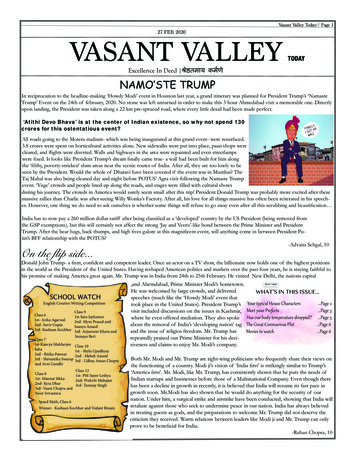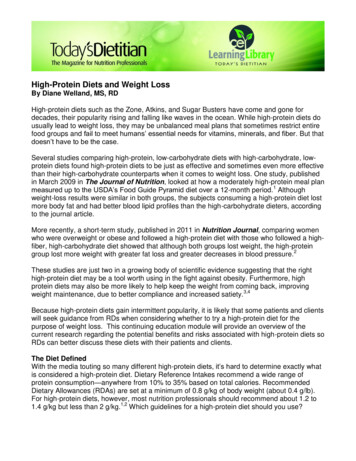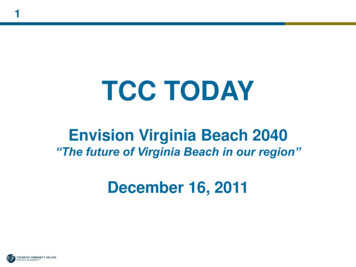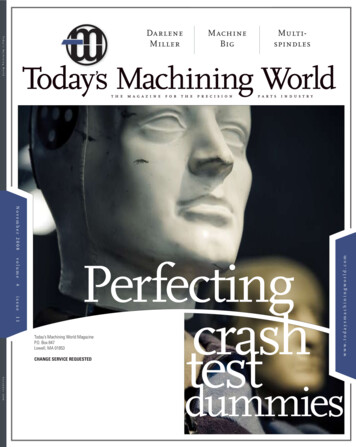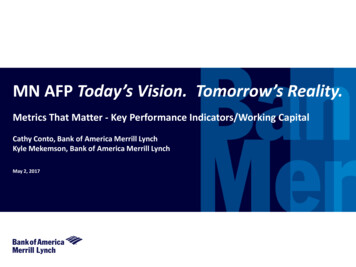
Transcription
MN AFP Today’s Vision. Tomorrow’s Reality.Metrics That Matter - Key Performance Indicators/Working CapitalCathy Conto, Bank of America Merrill LynchKyle Mekemson, Bank of America Merrill LynchMay 2, 2017
Agenda 2IntroductionsWorking capital overviewKey performance indicator (KPI) overviewTreasury KPIsAccounts payable KPIsAccounts receivable KPIsReporting, communication plan and on-going processFinancial benchmarking & working capital analysisQ&A
Working Capital – a holistic viewA/RVisibilitySupply ChainFinancingLines ofCreditControlA/PLegal& sAccess ooling/NettingWorkingCapitalManagementWorking t ofCapitalFinancial RiskManagementSystems T&ERationalize/Standardize/Automate
Working Capital and Value CreationCapital structure as a driver of shareholder valueIncrease Transaction PricesReduce CostsOperatingIncrease Volume / Market ShareMaximize Cash Flowfrom Invested CapitalInternalReduce Capital IntensityLeverageRisk ManagementFinancialReturn of CapitalLiquidity ManagementOptimize Costof CapitalRatings ProfileMaximizeShareholderValueCyclical ” M&ASaleSpin-offCarve-out4Minimize Price Relativeto Value of Target PlusSynergy ValueMaximizeCorporate Clarity“Restructuring” M&A
Strategic Working Capital: beyond CCCFocus on how futureadditional volumewill be managedCapexExpansionEstablish goals/priorities given cultureand ownership of firmBuild better, automatedprocesses rather thanreplicate old processesNewLeadershipNewERPCapture cost synergies sodeal becomes accretive andadds value porate “lean”Finance/Treasuryconcepts to lower costsMaintain control/visibility oninternational opsReview policies andensure tight controlsare in place
Metrics vs. KPIsWhat gets measured, gets managedMetrics A numerical measure designed to identify and help manage specific activities,financial line items or risk present in ordinary operations. Provide an unbiased means of measuring the performance and activities of anorganization.KPIs All KPIs are metrics. Represent the ‘critical few’ metrics that are the most important to achievingsuccess. Measures how effective an organization is at achieving the business targets orstrategy.6A KPI is a metric that you have chosen, and agreed with yourbusiness partners, that will determine whether you aremeeting your critical success factors.
Key performance indicators (KPIs)You can’t get fromthere to here withoutthe right tools.Navigation:To plan, monitor and control the course and position ofsomeone or something from one place to another.CONTROL7EFFECIENCYSUPPORT
Treasury’s transformationEvolve from a tacticianto a strategic advisor.132Increase transparencyacross the organization54Identify shortfalls andinefficient processes8Link treasuryperformanceto corporate goalsAnalyze and optimizeprocessesMaintain
Transformation and transparencyTransformation involves lifting theveil of secrecy surrounding treasury.Improved performancemetrics establishtreasury’s commitmentto excellence.Increased transparency maybe uncomfortable at first.9
What are you trying to measure and why?Metrics shouldn’t exist in a vacuum. Is the effort linked to a new strategy?Are there issues facing the department/company?What are the end goals of the effort?What do you hope to accomplish through metrics?What will you be comparing the results to?What will you do with the results?Metrics are a powerful tool that cantransform how your team functions.10
Nature of metricsStrategic Track treasury’s contribution toa new project or objective Develop on an “as needed”basis Not relevant once project orobjective is complete11Tactical Track the efficiency of processes,minimization of error rates andachievement of returns on assets Activities are recurring
Treasury key performance indicatorsCash forecast accuracy Investment income, interest expense, bank fees, trustee fees, etc.Liquidity and cash Percent of daily cash balances vs. forecast Percent of non-interest bear cash vs. total cash Percent of restricted cash vs. total cash Days cash available Percent of committed credit vs. total credit availableExposure management Variance to market rate at time of trade (trade rate – market rate at time of trade)/market rate Fixed / Floating rate mix Hedge percent principle value of identified hedged exposures/principle value of total identifiedexposuresDebt management Short term vs. long term debt mix Debt vs. Equity mix All-in interest rate vs. benchmarkInvestment performance Portfolio credit rating (weighted average credit ratings vs. stated policy target) Maturity structure/schedule12
Accounts payable key performance indicatorsWorking capital optimization: Average days paymentoutstanding (DPO) cash discounts taken rebatesCycle time: Invoice cycle time (receipt toscheduled for payment)Cost effectiveness: Unit cost to process an invoice Unit cost to process a paymentStaff productivity: # Invoices processed perAccounts Payable FTE # Payments per Accounts PayableFTEProcess efficiency: % Invoices straight-throughprocessing (3 way match) % Electronic invoices % Electronic payments (ACH,card) % Cash discounts available thatare takenOther: % Vendor portal utilizationMeasuring success13
Procure to pay metricsVendor managementKey inputs Vendor contractsProcurement policesVendor master dataproceduresPO & receipt Metricsprocess inputs Purchase orders (paper &electronic)Contract terms andpricingGoods sent/servicesperformedAdvanced Shipping Notice(ASN) POs #ASN # New and updated vendormaster dataPayment terms & cashdiscounts determinedInvoice format andpayment informationenteredVendor performance PO invoices (paper &electronic)Non PO invoices (paper &electronic)3 way match capabilitiesApproval hierarchy/policy& routing process Key outputsNew vendor contractsapproved/signed #PaymentssentInvoicingGoods receivedASN matched to goodsInventory updated PO invoices #Non PO invoices #Time to approve # (days)AP Invoice processingFTEs # Invoice discrepanciesresolvedInvoices approvedInvoices set to pay Terms, due date, paymentmethod, bank info & cashdiscounts offered pervendor masterFinal paymentreview/approvalCheck pre-registerPayment files createdReconciliation & reporting Payment cycle runs #Invoices ready to paybased on terms #, %Disbursement FTEs #Payment cycle runsChecks issued & mailedACH file sentWires processedCredit card payments sentPositive pay file sentMetricsProcess outputs POs electronic #, %ASN #, % Electronic invoices #,% Invoice cycle time # (days) Invoices per FTE # 14Vendors with standardterms #, %Vendor paymentmethods #,%Vendors with cashdiscounts % 2 way match % (PO, ASN)Electronic payments %Unit cost: Cost perpayment Cash discounts taken Rebates Auto match “no touch” (2/3 way) %Average Days Payable Outstanding DPO Payments by type (check,ACH, card, wire) #, Payments on time basedon terms %Cash discounts availablethat were taken %Payments per FTE #3 way match % (PO,receipt, invoice)Unit cost: Cost per invoice MetricsE2E outputsNew vendors entered #Active vendors #Preferred suppliers #,%Vendor scorecards #,%Vendor reviews #,% Payments issuedChecks clearedAP transactionsOn line bank access andreportsEscheatment policyCash forecast templateCustomer service AP sub ledger reconciled toGLGL reconciled to bankChecks outstandingAccrualsEscheatment itemssubmittedMonthly AP MgmtreportingCash forecast for payables Reconciling items #, Escheatment items #, Cash forecast variance % ProcurementVendorphonesystemcallsAP systemVendorcorrespondenceReports Portal data filesVendorOn line bank access andreportsVendor Portal & dataupdatesVendor phone calls #Vendors with access toPortal #, %Vendor inquires &problems resolvedVendor Portal dataaccurate & available 24/7# of inquires andproblemsRoot cause analysis ofinquires and problemsVendor Portal utilization %
Accounts receivable key performance indicatorsWorking capital optimization: Average days sales outstanding(DSO) measured against bestpossible days sales outstanding(BPDSO)Cycle time: # days to resolve paymentdiscrepancies (deductions)Cost effectiveness: % Invoice accuracy Unit cost to apply a payment Unit cost to collect % Invoices over 60 days Bad debt/write-off expensesStaff productivity: # Receipts processed perAccounts Receivable FTE # Active customers perCredit/Collections FTEProcess efficiency: % Electronic invoices % Electronic payments % Payment application auto hitrate (no touch) # incurred deductions % collection effectiveness indexOther: Cash tolerance (small balance)write offs #, , average amountMeasuring success15
Order to cash metricsCredit & customerSet upMetricsProcess InputsKey Inputs Key Outputs New /existing customercredit apps received #Set up/amendments # Sales ordersCredit limit and termsContract terms andpricingBilling informationBilling proceduresBilling FTEs #Time to invoice # (days)PaymentsreceivedPaymentapplication ChecksACH paymentsWiresCredit card chargesCustomer remit detailPayment instructionsBank files Total daily receipts #, MetricsProcess OutputsCompleted customerapplicationCredit policesMaster data proceduresFulfillment &invoicing New and updatedcustomer master dataCredit terms determinedBilling and paymentinformation entered Electronic or paperinvoice sent to customerReconcile billing & AR New/existing credit appsprocessed #Set up/ Amendmentsprocessed #Denied # and reasons Invoices created #, Paper invoices #Electronic invoices #Errors by reason #, , %Weighted average daysunbilled Payments processed &electronic file transmittedACH remit data transmittedFiles uploadedFile created andtransmitted to HighRadiusList of payments to beapplied manually (wires,credit cards) ACH, credit card, check,wire #, , % MetricsE2E OutputsCustomers withstandard terms % EDI %Unit cost: Cost to invoice 16 ACH %Payment file to HighRadiusMICR table to HighRadiusCash applicationprocedures, business &customer specificapplication rulesCash and deduction reasoncodes Total daily receipts sentto HighRadius #, Total daily receiptsapplied manually #, Payment application FTEs# Applied items closedautomatically (STP)Items on accountItems unprocessedOver/short pays codedSmall balance auto writeoff Deduction management& collections Total unapplied cashcoded by type and aging#, , %Total applied by pay type#, Payment application cycletime # (days)Receipts per FTE # Auto hit rate “no touch”%Unit cost: Paymentapplication Invoice accuracy %Average Days Sales Outstanding DSO (compared to bestpossible DSO) Accounts Receivable Turnover ART ratio % Aged trial balanceCustomer billing info andcredit termsCollection and deductionproceduresOpen invoices, paymentsand deductionsReconciliation& reporting AR transactionsOn line bank access andreportsCash forecast templateWrite off account detailAverage Days DelinquentADD # (days)Collectors FTEs #Incurred deduction #, Collection letters generate;phone calls made; activitiesdocumentedInvoices paidInvoices marked for writeoff/bad debtDeductions written off orcredit memos issuedOver payments applied orwritten off or refunded Open AR past due , %% CurrentRepays #, , %Deductions closed byreason #, Deductions per FTE #Collections per FTE # Collection EffectivenessIndex CEIUnit cost: Collections Average Days DeductionsOutstanding DDOUnit cost: Deductions AR sub ledger reconciled toGLGL reconciled to bankReserve and write offanalysisBad debt reserve updatedMonthly AR MgmtreportingCash forecast forreceivablesReconciling items #, Cash tolerance write offs#, , average amountBad Debt to Sales %Bad Debts #, Cash forecast variance %
Management reportingScorecard exampleReporting & dashboard examples17 Scorecard Management report Dashboard
Communication planOnly include metrics that are meaningful to the t the number ofmetrics to eight or fewerReporting that showperformance againstgoals/benchmarksMake sure the message iseasy to understandOngoing feedback loop:Gather input fromstakeholders18Revise KPIs &performance targetsCommunicatechange
The way forward roadmapCalibrateRecognizeScorecardDefineKPIs19and adjust.Reward achievement and celebrate successes.Focus and reinforce the major initiatives that willPrioritiesAlignEvaluate relevancedrive improvement.Cascade to individual performance plans.Measure and report the output to keystakeholders.Identify the measurements, benchmarks, goals andprocess to gather data.Determine the right KPIs based on strategicimperatives.Delivering results
Summary Tracking and communicating KPIs is critical totransformation and success.Reward achievements and celebrate successes.Periodically reassess relevance of measures andrevise goals.Measure, monitor and reward!!!20
Financial benchmarking & workingcapital analysis
Financial BenchmarkingValue PropositionBenefits of benchmarking versus peer companies:Create sense of urgencyIdentify best in classEstablish clear targets withmeasurable resultsFacilitate out of the boxthinking and new ideasSource: Sustainability Advantage: Benefits of a Gold standard Benchmark22
Financial BenchmarkingTypical ProgressionFive stages of benchmarking:PlanningAnalysisStep 1: Indentify what is Step 4: Determineto be benchmarkedcurrent performance‘gap’Step 2: Identifycomparable companies Step 5: Project futureperformance levelsStep 3: Determine datacollection method andcollect dataIntegrationStep 6: CommunicateStep 8: Develop actionbenchmark findings and plansgain acceptanceStep 9: ImplementStep 7: Establishspecific action andfunctional goalsmonitor progressSource: Company Benchmarking for Competitive Advantage by Terry Pilcher Assistant Director – Department of Trade and Industry, UK23ActionStep 10: RecalibratebenchmarksMaturityLeadership positionattainedBest practices fullyintegrated into process
Financial BenchmarkingResources for InformationFinancial benchmarking resources for middle market companies:Industry TradeAssociationsVendors (D&B/ Hoovers)BankingPartners(RMA data)Public Comps(CapIQ/FactSet)CPAs /Consultants24IRS and otherGovernmentSources
Financial BenchmarkingMetrics that Drive Corporate Decision Making & Behavior Debt / EBITDA Interest Coverage RatioCredit Profile Cash Liquidity Profile Bank and Credit Ratings Effective Borrowing Rate Invested CapitalEfficiency Cash Conversion Cycle Working Capital (DPO, DSO, DIO) Fixed / Floating debt mix Currency of Debt vs. Currency of EarningsRisk Management25 Foreign Exchange
Financial Benchmarking Output ExampleMarket Trends Overview & Peer AnalysisClient Type: PublicClient Industry: Specialty Equipment ManufacturingCompetitive Landscape: US Specialty Equipment Market Demand is driven by consumer spending The profitability of individual companies depends on effective marketing, efficient production, and productinnovation Large companies have economies of scale in purchasing and production Small firms can compete by making specialty products The industry is highly concentrated with the top 50 companies accounting for more than 95% of industryrevenue U.S. exports of specialty equipment are small; imports come primarily from China, Japan, Canada and TaiwanSource: First Research26
Specialty Equipment ManufacturingFactors Driving the Industry: U.S. More Powerful, Efficient Equipment: Specialty equipment manufacturers are developingmore products with fuel-injected engines to reduce emissions and improve fuelefficiency. Lithium-ion battery and brushless motor technologies have increased powerand runtime and reduced charging times for battery-powered equipment Life-Cycle Management: Manufacturers are working to better manage the life cycles ofproducts to reduce waste and increase recycling. Equipment manufacturers work withhome centers and other retailers to promote battery recyclingTrendsFactorsDriving theIndustry27Offshore Manufacturing Facilities: Lower costs for labor and operations aredriving more companies to manufacture in developing regions. Dispersingfacilities internationally helps protect companies from regional economicdownturns and positions plants closer to alternative sources of raw materials,as well as tonew markets Multichannel Marketing: Home centers and mass merchandisers account forabout 80% of U.S. Specialty equipment sales. However, customers increasinglyresearch products online, and use retailer and manufacturer websites tocompare equipment features and pricingOpportunities Volatile Raw Materials Costs: Raw materials costs can represent more than 65% ofsales. Certain Specialty equipment contains large amounts of steel, and steel prices canrise 30% or more in a year. The inability to pass raw materials price increases on tocustomers can reduce margins Product Liability: Specialty equipment often have moving parts that can cause injury ifmisused, or if products have manufacturing defects. Companies self insure or purchaseinsurance to protect against losses from product liability claimsChallengesSource: First Research
Specialty Equipment ManufacturingMarket Threats & TrendsBargaining Power of SuppliersLOWThreat of RivalryHIGHLeading players like Husqvarna and Toro aremaking investments in developing countries likeChina and India. Their financial power may posea significant threat to start-upsThere are several suppliers of essential rawmaterials like steel, rubber, glass, and plastic.This makes the bargaining power of supplierslowBargaining Power of BuyersMODERATEThreat of SubstitutesMODERATEThere are only a few successful and establishedvendors in the market; hence, the bargainingpower of buyers is moderateManual labor is a substitute for power lawnmowersThreat of New EntrantsMODERATESource: TechNavio28The market has huge growth potential. Owingto this many start-ups may be willing to enterthe market, however, lack of sufficient fundsand technology may restrict them from enteringthis market
Operational Benchmarking Example 1Operational Growth15%2013A – 2015ARevenueCAGR10%Median: 5.1%Average: .0%40%2013A – 2015AEBITDACAGR20%10%16.5%9.6%10.9%Co ACo BMedian: 18.6%Average: .5%0%Co CCo DCo ECo FCo GCo HCo ICo JCo KEBITDA Margin Performance30%2015A EBITDAMargin20%Median: 10.5%Average: 0.56%5.71%6.37%4.01%0%30%2014A %12.08%Median: 12.2%Average: 12.7%13.72%10%6.11%7.37%Co ICo J4.66%0%Co A29Co BCo CCo DCo ECo FCo GCo HCo K
Operational Benchmarking Example 2LQTR Unused Revolver % of LTM RevenueLQTR Cash % of LTM Revenue %24%15%15%5%15%14%9%0%Co BCo KCo ECo CCo GCo FCo HCo JCo IReceivablesInventory9%9%5%6%5%4%Co DCo H0%Co FCo ALTM Working Capital Cycle30013%5%2%Co D28%Co GCo KCo JCo B7%2%2%1%Co ICo CCo ECo ALTM Free Cash Flow / 232415060%42646011511450280Co A3060Co D62Co B47Co E40%71%205869967270Co F66Co CCo G30%882120%773530Co H2834Co ICo J5310%17%14%13%Co KCo HCo DCo FCo C14%13%9%7%7%5%4%Co GCo KCo JCo ECo BCo I0%Co A
Individual Company Trends Benchmarking1000424.37Peer WorkingCapital Development423.76 468.6 429.8 483.3 entoryPayables0-500FY 2011FY 2012FY 2013FY 2014FY 2015Latest QTRNet Working Capital15010
Accounts payable KPIs Accounts receivable KPIs Reporting, communication plan and on-going process Financial benchmarking
